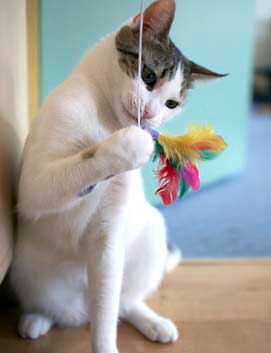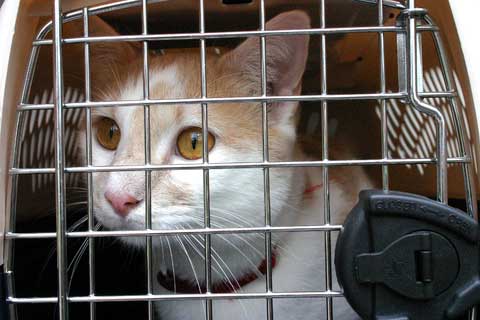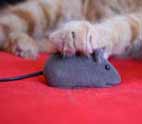Cat Training Techniques
For Fun and Necessity
Cat training is a reality. Yes i know many people believe cats cannot be trained because unlike dogs they are independent animals. but with a little patience, they can actually learn new behaviour quite easily.
there are many reasons you may want to train your cat and I will cover the main ones here and on adjoining pages in lore detail.
Guide to this page
Benefits of Training / Methods of Training / Why Train Your Cat / Litter training / Furniture scratching / Introducing pets / leash training / Carrier and travel / Fun
The Benefits of Taining Your Cat
There are two main benefits:
- It provides stimulation for your cat, especially if they live inside only. A bored cat is a unhealthy and sometimes destructive pet.
- It helps to make the bond between cat and owner much stronger. cats who spend lots of time interacting with their owner are often much happier and friendly pets.
Methods of Cat Training

Now because our furry friends don’t understand English (although I personally think they do learn some of the language, even if only at the most basic level), to be able to train your cat to do anything, we must find out how they learn to do things their way.
Cats learn by experience. If it’s a good experience like sharpening their claws on that nice new chair they will do it again. If it’s a bad one, like burning their whiskers on a candle they won’t do it again.
There are two main methods of training.
Reward Training
So our first lesson is to realize, that to get our cats to do or not to do something, we have to make the experience either a bad one or a good one.
using your cats favourite treats is a good way of getting their attention and rewarding good behaviour getting a treat is a pleasurable experience for your cat and one they want to repeat often.
So by associating a good response such as sitting or coming when they are called with receiving a treat will ensure that you get this response every time.
- Make sure you use only their most favourite treat during a training session.
- Only give a small piece each time.
- Don't use their favourite treat often generally. keep it for training purposes only,
Remember the golden rule. Treat and praise good behaviour. Never react to bad behaviour.
Positive Environment

Making sure that from the very first day that you bring your cat home you provide only a positive environment for your cat to live in. Will help to avoid behaviours which can cause problems such as scratching furniture, cat urine puddles and walking on food surfaces. Here are three things to keep in mind:
Never shout at your cat for doing a wrong thing. They just won’t understand and will in fact only make them more anxious.
Create a cat positive environment.
- Make sure that litter trays are provided and that they are situated suitably.
- Areas are provided where your cat can display some of their natural instincts like sharpening claws. So make sure you give them scratching posts to prevent furniture being clawed and reduce the need for any cat training in this area.
- Provide places they can feel safe such as perches to climb up onto and quiet areas they can escape to.
- A Pet Door can also help give your cat some freedom to come and go as they wish.
Make sure your cat does not get bored.
A bored or neglected cat can be a destructive cat. Give them toys to play with and your undivided attention at least once every day.
Clicker Cat Training
Using a clicker to train your cat to perform a certain behaviour can be a really useful tool.
the clicker works by associating the sound of the clicker with a positive response such as receiving a treat. You then associate the clicker and the treat with a particular behaviour like sitting down or rolling over.
Eventually the cat will learn that the sound of the clicker requires them to perform that behaviour and that they will get a treat. Or course clicker training can be used in an advanced way to get your cat to perform lots of fun tricks too.
Types of Cat Training
So why would you need cat training techniques?
Changing Behavior
Issues can arise where a cat owner may want to try and change the cats behavior. Sometimes it's because the cat is doing something we don't like, sometimes its to get the cat used to certain situations. Issues like:
Cat Litter Training
- One of the first times you may want to train your cat to do something is when you first bring them to your home and want them to get used to their new litter tray. Training tips here.
Stop Furniture Scratching
- This is a common problem for cat owners. cats just love to sharpen their claws on whatever they want. This behaviour can be changed with a few simple techniques. Read about them here.
Getting Cats Used To Each Other
- Often introducing a new pet to the home will upset your cat and fights and upsets can become quite nasty. However with some simple training sessions with your pets together you can get them to accept each other, if not love each other in time. Please see my page about how to introduce pets to each other.

Practical Reasons
There are times when cat training is needed just to keep your cat safe.
Leash Training
- Not everyone has a safe garden or environment for their cat to roam but still want their cat to have the freedom to explore outside. training your cat to be on a leash when outside is the best option in these cases. Although this can be harder for some cats than others, most cats can learn to accept a leash in time. Find out how you can train your cat to walk on a leash.
Carrier and Travel Training
- Some cats hate to get into their carrier and owners can have a terrible time and even risk injury when a trip in a carrier is required. But by letting your cat get used to the sight and smell of their carrier before it is needed, really does prevent a lot of anxiety for the cat. travelling can also be a source of fear for your pet and making the experience one that is not out of the ordinary will help your cat through long journeys. Read my tips on how to train your cat not to be afraid of their carrier or travel.
For Fun
Of course you may simply want to wow your friends with some tricks that your super intelligent cat can perform. Cats can enjoy these too as they are interacting with you and getting some tasty treats too.
Remember though everything in moderation and don't ask your cat to do anything which could hurt or injure them.





